 Welcome to the fifteenth monthly Carnival of Computer Help and Advice - a digest of recent blog articles providing top tips for PC users. Because so many blog authors submitted high quality posts for inclusion this month, this carnival is a little longer than usual. Nevertheless, there is not enough space to include every submission, so apologies to those bloggers whose articles do not appear.
Welcome to the fifteenth monthly Carnival of Computer Help and Advice - a digest of recent blog articles providing top tips for PC users. Because so many blog authors submitted high quality posts for inclusion this month, this carnival is a little longer than usual. Nevertheless, there is not enough space to include every submission, so apologies to those bloggers whose articles do not appear.
We start with two posts that stress the importance of security of personal data whether it is stored on your hard-drive or, in the first case, being broadcast wirelessly. The author of Fine-Tuned Finances shares good advice about How to Safely Access Online Banking Sites from Public Wi-Fi Hot Spots. Barbara Brabec of Handmade for Profit - Cashing in on Your Creativity! says "If you've never had a total computer system crash, count yourself lucky, because it's not IF your computer is going to crash, but WHEN. How well you prepare for this inevitability will determine how painful and costly the crash experience will be." Thankfully, she helps us plan for this event in How to Prepare for a Computer Crash.
Viruses also pose a significant threat to the integrity of our computers. Thoughtfully Vikram author, VikramKir, presents Where can I Find Free Antivirus Software to Download? Review Free Anti-Virus Software Applications. Vikram also offers advice on Ways to speed up computer. Increase Performance of Windows Machine.
"Registry cleaner key clean up is the process that fixes most of the problems in the your Windows registry. What are the registry keys? Registry keys are the ones most often left behind when a program is installed. Those stray keys are some of information that the computer no longer needs, and finally they become clutter. Registry cleaner key clean up programs attempt to clear those out and make your computer running faster." So says the author of myprofit's Blog on Flixya.com. Their article Registry Cleaner Key Removal not only highlights the importance of cleaning the Windows Registry but also provides a good explanation of exactly what it is.
We have a few more Windows tips now, the first of which should be filed under 'Not for the faint-hearted': Lando presents Delete the Recycle Bin posted at Lando411 - Technology Articles, Tech Tips, Computer Tips, and more. For Vista users, The Egotistical Admin, Jason Beebe, shares his Tech Tip #1: Apply Folder Views to All Folders. For the computer novice, Kathryn explains How to Delete Browser Cookies from Internet Explorer on KathrynVercillo on eHow.
More freeware now, starting with two articles from Marco DSouza's Technology at work and play blog: Hard disk defragmentation: The easy, free way, and his review of a free backup application in Snappy, effective backups. AshPresent of ashPresentom gives us a chance to pimp our Windows desktop by telling us How to get Apple OS X Leopard Stack dock for Windows, and other docks
Finally this month, the author of gadget-cafe, switch2life, presents sensible advice for those who are Selecting a Laptop to buy.
If you are interested in hosting a future carnival please leave a comment on this post or use the contact form over at our Blog Carnival page where you can also submit your blog posts for inclusion. Don't worry, if you don't want to write the Carnival post I can do it for you.
See you all in April. Keep up the good work.
Friday, 27 March 2009
The 15th Carnival of Computer Help and Advice
Posted by
Borkiman
at
09:45
10
comments
![]()
Labels: Blog Carnival
Wednesday, 18 March 2009
What to do when Windows hangs (revisited)
So, your PC isn't doing anything, the screen is a mess, the hard-drive is whirring away. Is there anything you can do, rather than just reach for the reset button?
Here are my top tips for dealing with those times when Windows hangs.
Don't keep clicking things
Windows buffers (meaning that it remembers) all these clicks and will implement them when it catches up, preventing you from continuing with what you want to do, and possibly causing havoc. Show a little bit of patience.
Check to see if your PC has crashed
Before you hit that reset button it is wise to check if your PC has actually crashed. To do this simply press the Caps Lock key, and check whether the 'Caps Lock' light goes on or off; if it does then your session may be recoverable. You may have to wait a few seconds to see a response.
Try to close any non-essential applications
You can try to close any programs that don't have any of your precious work open in. Try right-clicking on their button on the taskbar (the bar with the time and the Start menu on it) and clicking 'Close'. A little patience may be required here if the machine is running slowly.
If your mouse is really slowed down you may have more joy with the keyboard. Hold down the alt key and press tab to change between programs. When the non-essential application appears try to close it by holding down the alt key and pressing F4.
Use the Task Manager All recent versions of Windows have a built in application called Task Manager. To run it simply hold down Ctrl and Alt, and press Delete (note: Windows 2000 users will then have to press the 'Task Manager' button on the dialog box that opens.)
All recent versions of Windows have a built in application called Task Manager. To run it simply hold down Ctrl and Alt, and press Delete (note: Windows 2000 users will then have to press the 'Task Manager' button on the dialog box that opens.)
As with all these tips, you will have to wait a while to see if it appears. When it does, check the 'Applications' tab to see if any of the programs you are running have a status of 'Not Responding.' If they are, click on one to highlight it then and click the 'End Task' button. Do this with any other programs that are not responding, then cross your fingers.
If Windows starts working again it is best to save all your work and restart the PC. A clean restart is always preferable to a nasty reset.
This is an updated and amended version of an article originally published on 19 September 2007.
Posted by
Borkiman
at
17:34
8
comments
![]()
Labels: Windows Crash, Windows Hangs
Friday, 6 March 2009
How to pin shortcuts to the Start menu
The left hand side of the Start menu in Windows XP and Vista includes a list of recently used applications at the bottom below the divider, and a list of 'pinned' items at the top, as shown below. You can add and remove shortcuts to this list of 'pinned' items in two ways. Firstly, you can simply drag-and-drop a shortcut from the bottom list to the top, as shown in the following video. Click on the icon in the lower list and hold down the mouse button while you drag the icon up above the divider.
You can add and remove shortcuts to this list of 'pinned' items in two ways. Firstly, you can simply drag-and-drop a shortcut from the bottom list to the top, as shown in the following video. Click on the icon in the lower list and hold down the mouse button while you drag the icon up above the divider.
Secondly, right-click on any shortcut and click on 'Pin to Start Menu'.
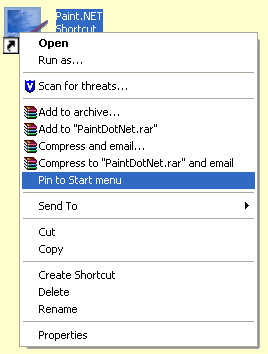
You can alter the order of the shortcuts by dragging and dropping them into their new position. To remove a pinned shortcut, right-click on it and select 'Remove from this list'. You can also alter the number of shortcuts displayed on the Start menu.
Windows XP
Right-click on the Start menu and click 'Properties' making sure the mouse pointer is not over an icon. You will then see a window like this.
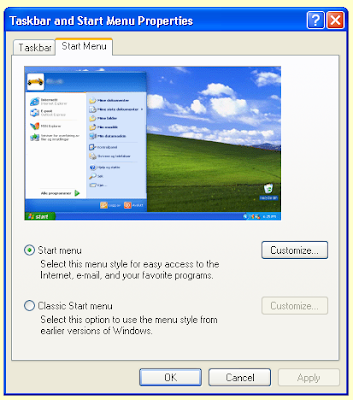 Click the 'Customize...' button to open the following window.
Click the 'Customize...' button to open the following window.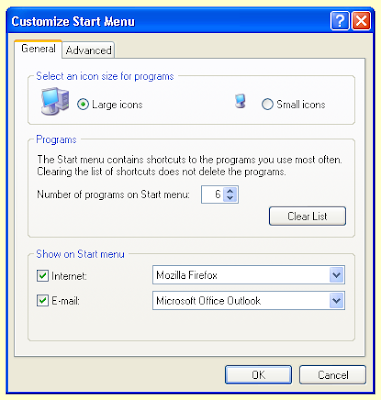
You can adjust the number of programs on the Start menu here. Other settings on this page include the size of the icons on the Start menu, a button to clear the recently used applications and a way to select the email and web browser applications that are displayed on the menu. Adjust these as you desire and click 'OK' to close that window, and 'OK' again to close the first window.
Windows Vista
Right-click on the Start menu and click 'Properties' making sure the mouse pointer is not over an icon. You will then see a window like this.
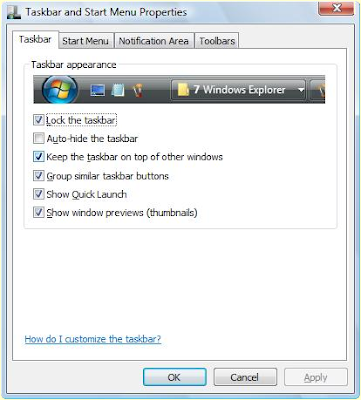 Go to the 'Start Menu' tab and click the 'Customize...' button.
Go to the 'Start Menu' tab and click the 'Customize...' button.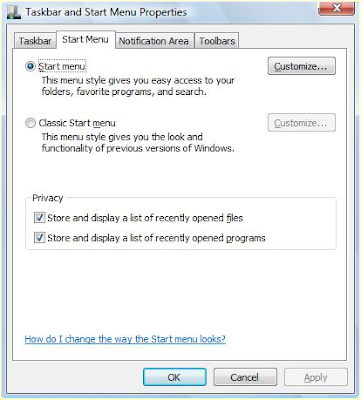
You can adjust the number of programs on the Start menu on the following window, as well a variety of other features on the Start menu.
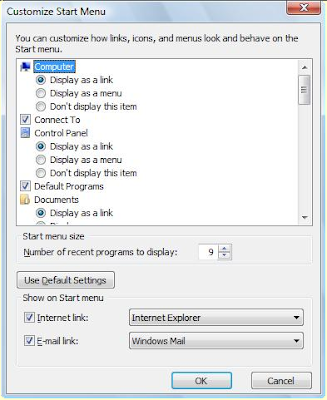
Once you have adjusted the settings click 'OK' on both windows to close them and implement the changes.











